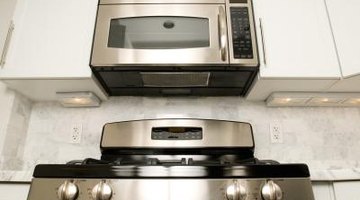How to Fix a Hinge on an Over-the-Range Microwave
Many manufacturers of microwave ovens offer over-the-range models. A problem with the door hinges can allow harmful microwave radiation to leak from the appliance. In many cases, cleaning the hinges is enough to get them working again. If the hinges are bent or broken, however, they must be replaced. Refrain from using your microwave until you've remedied the issue with the hinges.

Step 1
Shut off the power to the microwave from your home's main circuit breaker box. Push the breaker switch that supplies the electricity to the appliance to the "Off" position for the duration of your repairs.
Step 2
Remove the screws securing the air grille above the microwave door; the type and number of screws varies by brand and model. Pull the grille off of the front of the appliance and set it aside.
Step 3
Open the microwave door. Remove the hinge pin or screw holding the door assembly to the top hinge. Lift the door assembly up and off of the bottom hinge. Place the removed door face down on a padded surface.
Step 4
Clean the hinge areas with a sponge and warm, soapy water to remove any grime or food particles. Dry the hinges with a soft cloth. A buildup of food or grime on the hinges may prevent them from opening and closing properly.
Step 5
Try gently wiggling the door hinges. Tighten the hinge screws along the top and bottom edges of the microwave cabinet if you felt the hinges move.
Step 6
Replace the door hinges if they are bent or broken. Remove the hinge screws from the top and bottom edges of the microwave cabinet. Keep the removed screws, but discard the old hinges. Line up the screw holes on the cabinet with the mounting screw holes on the replacement hinges. Reinsert and tighten the removed screws.
Step 7
Reverse the disassembly process to replace the microwave door. Flip the breaker switch back to the "On" position to restore the electrical supply.
References
Resources
Tips
- Test the microwave for radiation leakage after fixing the door hinges. Microwave radiation testing kits are available from home improvement and online retailers. Use the testing kit according to package instructions to ensure that it's safe to operate your microwave.
Warnings
- Microwave ovens contain a high voltage capacitor that retains a deadly charge even after the appliance has been unplugged. Restrict do-it-yourself repairs to the door assembly and steer clear of the appliance's internal electrical components.
- Unauthorized repairs void the warranty on most types of microwaves. Contact the manufacturer for additional warranty and repair information.
Writer Bio
Megan Mattingly-Arthur has been writing professionally since 1998. She has contributed to various publications, including "Teen Voices" and "Positive Teens" magazines, as well as a book, "The Young Writer's Guide to Getting Published." Mattingly-Arthur is studying travel and tourism through Penn Foster Career School.
Photo Credits
- Jupiterimages/Photos.com/Getty Images
More Articles
- How to Adjust the Tension on a Kenmore Oven Door
- How to Remove the Oven Door on a Viking Range
- How to Remove Soap Scum From Shower Doors and Walls with Common Household Products
- How to Clean a Black & Decker Toaster Oven Door
- How to Fix a Frigidaire Microwave Door Switch
- How to Reface Bathroom Cabinets and Replace Doors



